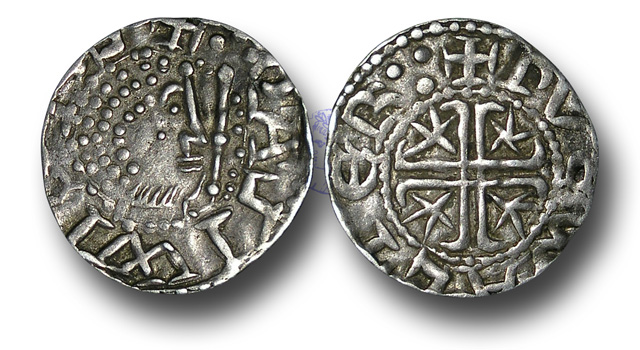William the Lion (Mediaeval Gaelic: Uilliam mac Eanric (i.e. William, son of Henry); Modern Gaelic:
 |
| William I 'The Lion' (1165-1214), Penny, 1.50g., Short Cross and Stars coinage, Phase B (c.1205-c.1230), the Edinburgh and Perth moneyers Hue and Walter working together, head right with a crown |
He became king following his brother Malcolm IV's death on 9 December 1165 and was crowned on 24 December 1165. In contrast to his deeply religious, frail brother, William was powerfully built and headstrong. He was an effective monarch whose reign was marred by his ill-fated attempts to regain control of Northumbria from the Normans. Traditionally, William is credited with founding Arbroath Abbey, the site of the later Declaration of Arbroath.
 |
| William's Seal |
William was grandson of David I of Scotland. He also inherited the title of Earl of Northumbria in 1152 from his father, Henry of Scotland. However he had to give up this title to King Henry II of England in 1157. This caused trouble after William became king, since he spent a lot of effort trying to regain Northumbria.
 |
| William of Scotland |
Henry then sent an army to Scotland and occupied it. As ransom and to regain his kingdom, William had to acknowledge Henry as his feudal superior and agree to pay for the cost of the English army's occupation of Scotland by taxing the Scots. The church of Scotland was also subjected to that of England. This he did by signing the Treaty of Falaise. He was then allowed to return to Scotland. In 1175 he swore fealty to Henry II at York Castle.
 |
| William's coin |
The humiliation of the Treaty of Falaise triggered a revolt in Galloway which lasted until 1186, and prompted construction of a castle at Dumfries. In 1179, meanwhile, William and his brother David personally led a force northwards into Easter Ross, establishing two further castles, north of the Beauly and Cromarty Firths; one on the Black Isle at Ederdour; and the other at Dunkeath, near the mouth of the Cromarty Firth opposite Cromarty. The aim to discourage the Norse Earls of Orkney from expanding beyond Caithness.
A further rising in 1181 involved Donald Meic Uilleim, descendant of King Duncan II. Donald briefly took over Ross; not until his death (1187) was William able to reclaim Donald's stronghold of Inverness. Further royal expeditions were required in 1197 and 1202 to fully neutralise the Orcadian threat. The Treaty of Falaise remained in force for the next fifteen years. Then the English king Richard the Lionheart, needing money to take part in the Third Crusade, agreed to terminate it in return for 10,000 silver marks, on 5 December 1189.
William attempted to purchase Northumbria from Richard in 1194, as he had a strong claim over it. However, his offer of 15,000 marks was rejected due to wanting the castles within the lands, which Richard was not willing to give.
 |
| Henry II coin |
Despite the Scots regaining their independence, Anglo-Scottish relations remained tense during the first decade of the 13th century. In August 1209 King John decided to flex the English muscles by marching a large army to Norham (near Berwick), in order to exploit the flagging leadership of the ageing Scottish monarch.
As well as promising a large sum of money, the ailing William agreed to his elder daughters marrying English nobles and, when the treaty was renewed in 1212, John apparently gained the hand of William's only surviving legitimate son, and heir, Alexander, for his eldest daughter, Joan.
Despite continued dependence on English goodwill, William's reign showed much achievement. He threw himself into government with energy and diligently followed the lines laid down by his grandfather, David I. Anglo-French settlements and feudalization were extended, new burghs founded, criminal law clarified, the responsibilities of justices and sheriffs widened, and trade grew. Arbroath Abbey was founded (1178), and the bishopric of Argyll established (c.1192) in the same year as papal confirmation of the Scottish church by Pope Celestine III.
According to legend, "William is recorded in 1206 as curing a case of scrofula by his touching and blessing a child with the ailment whilst at York. William died in Stirling in 1214 and lies buried in Arbroath Abbey. His son, Alexander II, succeeded him as king, reigning from 1214 to 1249.

No comments:
Post a Comment